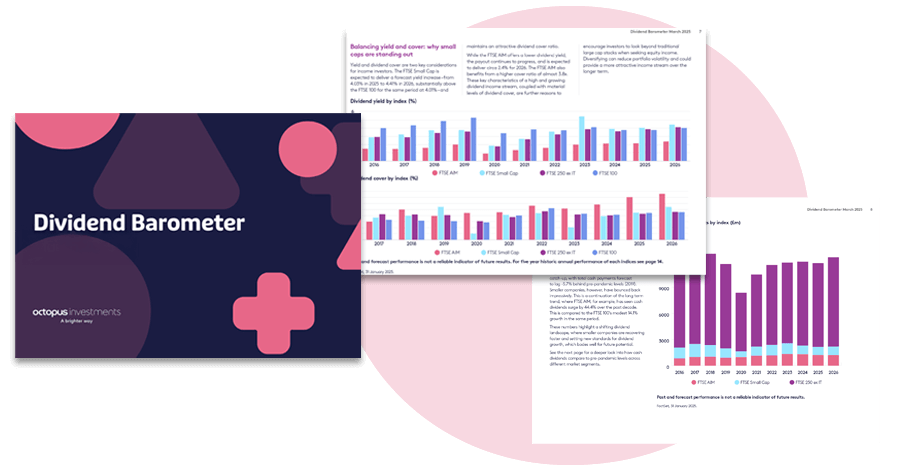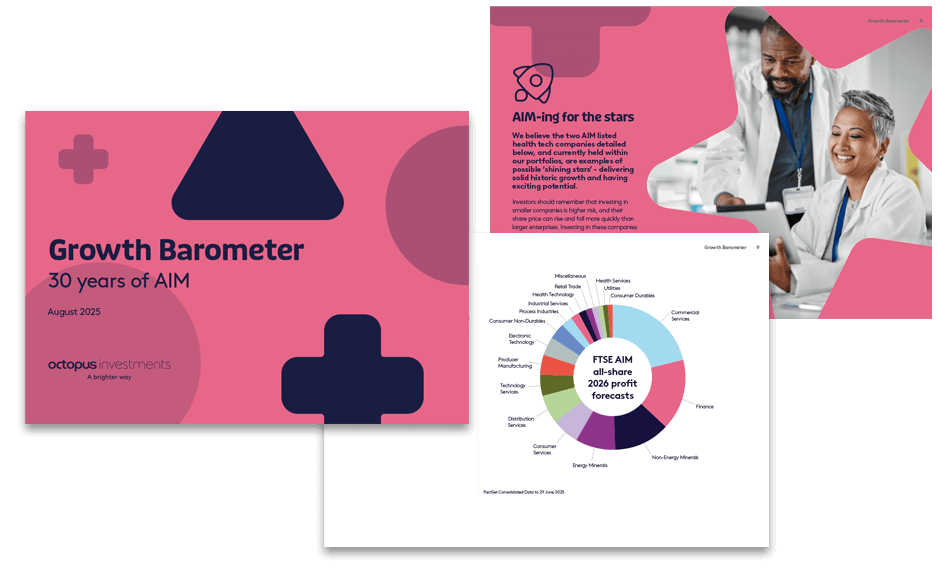AI has come a long way since Alan Turing first posed the question of whether machines could think in the 1950s. Today, it’s reshaping industries, sparking debate, and attracting billions in investment. Yet while headlines highlight frothy valuations, rising energy costs, and the limitations of current models, few doubt that AI is still in the early stages of a decades-long journey. The real debate is not whether AI has peaked, but whether markets are getting ahead of themselves in pricing in adoption and economic impact as if it will unfold seamlessly and overnight.
At Octopus Investments, we’ve spent over a decade backing early-stage business to business (B2B) software companies, and we believe AI represents the most profound shift yet. Unlike incremental technology upgrades, AI is a once-in-a-generation technological change, on the scale of the internet or mobile, but perhaps far greater. It is not just reshaping products, it is re-wiring how entire industries operate from healthcare and financial services to legal and infrastructure. The scale of the opportunity is immense: almost every business process that depends on human judgment, repetition, or data can be re-imagined.
This transformation is being driven not by a handful of public large corporates alone, but by thousands of emerging companies building the applied AI layer across verticals. And because these companies are still private, the most exciting growth remains accessible only through private markets. To explore this opportunity, we spoke to Adam Said, one of our Investment Principals, who’s been immersed in advancing our thinking on our B2B AI strategy. His insights reveal why we believe private markets are the gateway to this next wave of innovation – and why now is the time to pay attention.
“We’re seeing some of the fastest levels of revenue growth in B2B software we’ve ever seen – driven by AI’s ability to solve problems that traditional software simply couldn’t”.
Adam Said, Octopus Ventures
What’s really happening beneath the hype?
Behind the noise of billion-dollar valuations and media headlines, a quieter story is unfolding: AI is already creating measurable impact inside businesses. From automating back-office tasks to helping knowledge workers focus on higher-value work, we’re seeing productivity gains that traditional software could never deliver. The hype cycle is real, but so is the progress.
And in B2B software especially, the opportunity is not abstract, it’s happening in the workflows, processes, and industries we interact with every day. Which leads to the critical question: how do we, as investors, make sense of the types of companies best positioned to capture this wave? How do we ensure our existing portfolio companies are equipped to take advantage of this technology in the same way that newer companies can?
The AI opportunity in B2B software
At Octopus, we view the landscape through a predominantly B2B lens, where the potential to transform how organisations, healthcare systems and governments operate and to improve industries and society at large is greatest. Within this world, we see three distinct types of companies emerging:
- Traditional B2B Software – established Software platforms solving critical problems without AI at their core. Many continue to grow steadily, and we remain active investors here, especially where the technology is deeply embedded.
- AI-enabled B2B Software – traditional platforms proactively embedding AI features into existing products, unlocking new capabilities and delivering more value to their customer bases.
- AI-native B2B Software – startups built from the ground up with AI at their core, using intelligence layers to automate, predict, and re-imagine workflows in ways conventional software simply couldn’t.
Although we continue to invest across the full spectrum, it’s the latter two categories where we are indexing more heavily today. AI-native startups are seizing the moment to reshape markets, while AI-enabled Software incumbents enjoy a unique distribution advantage: hundreds of embedded customers, trusted relationships, and integration into workflows that new entrants would die for.
The strategic tension is clear: can incumbents innovate fast enough before AI-native challengers solve for distribution? The answer will vary by sector, but it’s a dynamic that will define the winners and losers of this new era of enterprise software.
Where AI is already delivering results
It’s easy to get lost in abstractions about “AI transforming industries,” but the evidence is already here. Across our portfolio, we’re seeing companies apply AI in highly specific contexts to deliver measurable value:
- Lyrebird Health – Doctors spend as much as a third of their time on clinical documentation. Lyrebird’s AI-powered medical scribe reduces that burden dramatically, saving hours each week and allowing clinicians to spend more time with patients.
- Definely – In legal services, lawyers often burn countless hours cross-referencing definitions and clauses. Definely uses AI to surface and check this information instantly within documents, saving lawyers 45 minutes a day on average and improving accuracy in the process.
- Vyntelligence – In field-based industries like utilities and telecoms, Vyntelligence replaces paperwork-heavy reporting with guided video capture analysed by AI. The result: faster inspections, fewer repeat visits, and smoother compliance.
- ThreatMark – In cybersecurity, rules-based systems struggle to keep up with evolving threats. ThreatMark uses adaptive AI to continuously learn from new patterns of fraud and attack, helping financial institutions stay ahead of risks.
What unites these examples is not flashy demos or hype, but practical impact on efficiency, productivity and cost. These are solutions that customers can’t imagine going back from once adopted.
Separating hype from sustainable value
The other side of the story is recognising the challenges. Not every AI company will thrive, and as investors we have to be clear-eyed about what it takes to build lasting value:
- Unit economics matter – Many AI products are costly to run, relying on expensive compute or third-party model APIs. Achieving software as a service or SaaS-like margins is far from guaranteed, therefore we are focusing heavily on paths to sustainable unit economics.
- Incumbent pressure – Big Tech is embedding AI into existing products and often offering it for free, putting pressure on startups that rely on point solutions.
- Enterprise inertia – Large organisations wrestle with messy data, slow procurement cycles and resistance to change. Pilots are easy, but scaling adoption is hard.
- Talent bottlenecks – Experienced AI talent is scarce and expensive, and startups must fight to attract and retain the people who can drive their edge.
- Defensibility and competitiveness – With open-source models and APIs widely available, features can be copied quickly. Proprietary data and workflow integration are key to building sustainable competitive positions.
This is why discipline is critical. We focus on companies with clear product-market fit, strong usage and retention metrics, and real-world ROI. The winners will be those that combine technical excellence with commercial execution, embedding themselves so deeply in customer workflows that they become indispensable.
What makes a great AI investment?
In a market that is fast-moving and often hyped, the strongest AI investments stand out by marrying technical excellence with commercial competitiveness. Most of the world’s data is dark – i.e. stuck inside organisations, messy, unstructured and rarely used. That is precisely why it represents the biggest opportunity. Companies that can unlock this data, make it usable, and apply AI to it are positioned to create trustworthy, repeatable use cases that drive real business transformation. Turning dormant enterprise data into actionable intelligence is where the real, long-term prize lies in B2B AI.
In our experience, the best AI companies share a common set of traits:
- Exceptional founding teams with deep technical expertise and sector-specific insight.
- Clear product–market fit, demonstrated through usage metrics, retention, and real-world impact.
- Proprietary data advantages or the ability to help enterprises unlock their own data creating competitive advantage by turning messy, underused information into structured, repeatable use cases.
- Scalable business models with recurring revenue, healthy unit economics, and a clear path to profitability.
- Sector focus and defensibility, embedding AI so deeply in workflows that it becomes indispensable.
Not every company will exhibit all of these traits from day one, but they form a useful guide. In a market where valuations can be inflated and trends move quickly, applying these filters is what separates hype from genuine innovation. This disciplined strategy helps us identify companies with real staying power, the ones building solutions that customers simply cannot operate without.
Public vs. private markets: Where does the real opportunity lie?
Much of the AI investment narrative has focused on public markets, particularly the “Magnificent Seven” (i.e. Nvidia, Amazon, Google, Apple) hyper-scalers building foundational models. These companies have built or backed the foundational infrastructure of AI, and if you own a piece of Microsoft, for example, you already have exposure to OpenAI, given Microsoft’s multi-billion-dollar investment, its significant ownership stake, and its deep integration of OpenAI’s models into Microsoft Office. But this concentration skews public market exposure heavily towards only a handful of players. The real innovation is happening in private markets, where thousands of vertical AI startups are emerging.
These companies are tackling niche, high-cost problems with sector-specific solutions. And because they’re early-stage, most of the time they’re only accessible through private market funds like a Venture Capital Trust (VCT). A Venture Capital Trust (VCT) is a company that buys small stakes in a large number of early-stage companies. For investors looking to participate in the AI revolution beyond the headlines, this is a unique opportunity.
However, given their mandate to invest in early-stage companies, it’s important to recognise that VCTs carry a high level of investment risk. We strongly recommend investors consult a qualified financial adviser before making any investment decision. The value of a VCT investment, and any income it generates, can fluctuate, and investors may not recover the full amount originally invested. Additionally, the value of a VCT can fall or rise more than that of companies listed on the main market of the London Stock Exchange. They may also be harder to sell.
While the AI companies that VCTs invest in will not be listed on a main market themselves, they may already be reshaping how industries operate, from automating back-office processes to fraud detection, forecasting, and customer service. We partner with them at earlier stages in these companies journey at the point where product-market fit is now clear, and the focus shifts to scaling execution.
Investing across the AI spectrum
At Octopus Investments, we focus on the application layer of AI – the companies using existing models to solve real business problems, not building the models themselves. Competing at the infrastructure level requires extraordinary capital and compute, and those gains will largely accrue to Big Tech. The greater long-term opportunity lies further up the chain, with businesses that can translate AI’s raw potential into tangible productivity gains, efficiency improvements, and customer value.
These are the companies turning theoretical promise into measurable economics. In other words, the ones that actually make AI useful.
If the foundational model layer is the oil, or, the electricity powering the revolution, then the application layer represents the cars, trucks, and machinery that convert that raw energy into real-world movement and productivity. We’re investing in the builders of that machinery – the practical enablers of transformation across a broad range of industries.
A Unique Gateway to the AI Opportunity
Via our VCTs, Octopus Investments offers diversified exposure across sectors and AI maturity levels. We have built deep expertise in B2B software, which is now evolving to meet the demands of the AI era.
For financial advisers and investors looking to access the B2B SaaS AI opportunity through private markets, this access provides a compelling gateway – without the hype, and with a clear strategy for long-term growth.
Want to learn more?
Stay tuned for updates on Apollo VCT’s next launch and explore how Octopus Investments continues to lead in early-stage B2B AI investing.
Any company examples are for illustrative purposes only. They should not be considered as an investment recommendation. This advertisement is not a prospectus. Investors should only subscribe for shares based on information in the prospectus, supplementary prospectus, AIFMD supplement and the Key Information Document (KID) which can be obtained from octopusinvestments.com.
AI has come a long way since Alan Turing first posed the question of whether machines could think in the 1950s. Today, it’s reshaping industries, sparking debate, and attracting billions in investment. Yet while headlines highlight frothy valuations, rising energy costs, and the limitations of current models, few doubt that AI is still in the early stages of a decades-long journey. The real debate is not whether AI has peaked, but whether markets are getting ahead of themselves in pricing in adoption and economic impact as if it will unfold seamlessly and overnight.
At Octopus Investments, we’ve spent over a decade backing early-stage business to business (B2B) software companies, and we believe AI represents the most profound shift yet. Unlike incremental technology upgrades, AI is a once-in-a-generation platform change, on the scale of the internet or mobile, but perhaps far greater. It is not just reshaping products, it is re-wiring how entire industries operate from healthcare and financial services to legal and infrastructure. The scale of the opportunity is immense: almost every business process that depends on human judgment, repetition, or data can be re-imagined.
This transformation is being driven not by a handful of public mega-caps alone, but by thousands of emerging companies building the applied AI layer across verticals. And because these companies are still private, the most exciting growth remains accessible only through private markets. To explore this opportunity, we spoke to Adam Said, one of our Investment Principals, who’s been immersed in advancing our thinking on our B2B AI strategy. His insights reveal why we believe private markets are the gateway to this next wave of innovation – and why now is the time to pay attention.
“We’re seeing some of the fastest levels of revenue growth in B2B software we’ve ever seen – driven by AI’s ability to solve problems that traditional software simply couldn’t”.Adam Said, Octopus Ventures
What’s really happening beneath the hype?
Behind the noise of billion-dollar valuations and media headlines, a quieter story is unfolding: AI is already creating measurable impact inside businesses. From automating back-office tasks to helping knowledge workers focus on higher-value work, we’re seeing productivity gains that traditional software could never deliver. The hype cycle is real, but so is the progress.
And in B2B software especially, the opportunity is not abstract, it’s happening in the workflows, processes, and industries we interact with every day. Which leads to the critical question: how do we, as investors, make sense of the types of companies best positioned to capture this wave? How do we ensure our existing portfolio companies are equipped to take advantage of this technology in the same way that newer companies can?
The AI opportunity in B2B software
At Octopus, we view the landscape through a predominantly B2B lens, where the potential to transform how organisations, healthcare systems and governments operate and to improve industries and society at large is greatest. Within this world, we see three distinct types of companies emerging:
- Traditional B2B Software – established Software platforms solving critical problems without AI at their core. Many continue to grow steadily, and we remain active investors here, especially where the technology is deeply embedded.
- AI-enabled B2B Software – traditional platforms proactively embedding AI features into existing products, unlocking new capabilities and delivering more value to their customer bases.
- AI-native B2B Software – startups built from the ground up with AI at their core, using intelligence layers to automate, predict, and re-imagine workflows in ways conventional software simply couldn’t.
Where AI is already delivering results
It’s easy to get lost in abstractions about “AI transforming industries,” but the evidence is already here. Across our portfolio, we’re seeing companies apply AI in highly specific contexts to deliver measurable value:
- Lyrebird Health – Doctors spend as much as a third of their time on clinical documentation. Lyrebird’s AI-powered medical scribe reduces that burden dramatically, saving hours each week and allowing clinicians to spend more time with patients.
- Definely – In legal services, lawyers often burn countless hours cross-referencing definitions and clauses. Definely uses AI to surface and check this information instantly within documents, saving lawyers 45 minutes a day on average and improving accuracy in the process.
- Vyntelligence – In field-based industries like utilities and telecoms, Vyntelligence replaces paperwork-heavy reporting with guided video capture analysed by AI. The result: faster inspections, fewer repeat visits, and smoother compliance.
- ThreatMark – In cybersecurity, rules-based systems struggle to keep up with evolving threats. ThreatMark uses adaptive AI to continuously learn from new patterns of fraud and attack, helping financial institutions stay ahead of risks.
What unites these examples is not flashy demos or hype, but practical impact on efficiency, productivity and cost. These are solutions that customers can’t imagine going back from once adopted.
Separating hype from sustainable value
The other side of the story is recognising the challenges. Not every AI company will thrive, and as investors we have to be clear-eyed about what it takes to build lasting value:
- Unit economics matter – Many AI products are costly to run, relying on expensive compute or third-party model APIs. Achieving SaaS-like margins is far from guaranteed, therefore we are focusing heavily on paths to sustainable unit economics.
- Incumbent pressure – Big Tech is embedding AI into existing products and often offering it for free, putting pressure on startups that rely on point solutions.
- Enterprise inertia – Large organisations wrestle with messy data, slow procurement cycles and resistance to change. Pilots are easy, but scaling adoption is hard.
- Talent bottlenecks – Experienced AI talent is scarce and expensive, and startups must fight to attract and retain the people who can drive their edge.
- Defensibility and competitiveness – With open-source models and APIs widely available, features can be copied quickly. Proprietary data and workflow integration are key to building durable moats.
This is why discipline is critical. We focus on companies with clear product-market fit, strong usage and retention metrics, and real-world ROI. The winners will be those that combine technical excellence with commercial execution, embedding themselves so deeply in customer workflows that they become indispensable.
What makes a great AI investment?
In a market that is fast-moving and often hyped, the strongest AI investments stand out by marrying technical excellence with commercial competitiveness. Most of the world’s data is dark – i.e. stuck inside organisations, messy, unstructured and rarely used. That is precisely why it represents the biggest opportunity. Companies that can unlock this data, make it usable, and apply AI to it are positioned to create trustworthy, repeatable use cases that drive real business transformation. Turning dormant enterprise data into actionable intelligence is where the real, long-term prize lies in B2B AI.
In our experience, the best AI companies share a common set of traits:
- Exceptional founding teams with deep technical expertise and sector-specific insight.
- Clear product–market fit, demonstrated through usage metrics, retention, and real-world impact.
- Proprietary data advantages or the ability to help enterprises unlock their own data creating defensibility by turning messy, underused information into structured, repeatable use cases.
- Scalable business models with recurring revenue, healthy unit economics, and a clear path to profitability.
- Sector focus and defensibility, embedding AI so deeply in workflows that it becomes indispensable.
Not every company will exhibit all of these traits from day one, but they form a useful guide. In a market where valuations can be inflated and trends move quickly, applying these filters is what separates hype from genuine innovation. This disciplined strategy helps us identify companies with real staying power, the ones building solutions that customers simply cannot operate without.
Public vs. private markets: Where does the real opportunity lie?
Much of the AI investment narrative has focused on public markets, particularly the “Magnificent Seven” (i.e. Nvidia, Amazon, Google, Apple) hyper-scalers building foundational models. These companies have built or backed the foundational infrastructure of AI, and if you own a piece of Microsoft, for example, you already have exposure to OpenAI, given Microsoft’s multi-billion-dollar investment, its significant ownership stake, and its deep integration of OpenAI’s models into Microsoft Office. But this concentration skews public market exposure heavily towards only a handful of players. The real innovation is happening in private markets, where thousands of vertical AI startups are emerging.
These companies are tackling niche, high-cost problems with sector-specific solutions. And because they’re early-stage, most of the time they’re only accessible through private funds like a Venture Capital Trust (VCT). For investors looking to participate in the AI revolution beyond the headlines, this is a unique opportunity.
Although these businesses may not be public yet, but they’re already reshaping how industries operate from automating back-office processes to fraud detection, forecasting, and customer service. We partner with them at earlier stages in these companies journey at the point where product-market fit is now clear, and the focus shifts to scaling execution.
Investing across the AI spectrum
At Octopus Investments, we focus on the application layer of AI – the companies using existing models to solve real business problems, not building the models themselves. Competing at the infrastructure level requires extraordinary capital and compute, and those gains will largely accrue to Big Tech. The greater long-term opportunity lies further up the chain, with businesses that can translate AI’s raw potential into tangible productivity gains, efficiency improvements, and customer value.
These are the companies turning theoretical promise into measurable economics. In other words, the ones that actually make AI useful.
If the foundational model layer is the oil, or, the electricity powering the revolution, then the application layer represents the cars, trucks, and machinery that convert that raw energy into real-world movement and productivity. We’re investing in the builders of that machinery – the practical enablers of transformation across a broad range of industries.
A Unique Gateway to the AI Opportunity
Octopus Investments offers diversified exposure across sectors and AI maturity levels. We have built deep expertise in B2B software, which is now evolving to meet the demands of the AI era.
For financial advisers and investors looking to access the B2B SaaS AI opportunity through private markets, this access provides a compelling gateway – without the hype, and with a clear strategy for long-term growth.
Want to learn more?
Stay tuned for updates on Apollo’s next launch, and explore how Octopus Ventures continues to lead in early-stage B2B AI investing.
Key risks to consider for VCTs:
- VCTs are a high-risk investment. The value of a VCT investment, and any income from it, can fall as well as rise. You may not get back the full amount you invest.
- Tax treatment depends on individual circumstances and may change in the future.
- Tax reliefs depend on the VCT maintaining its VCT-qualifying status.
- VCT shares could fall or rise in value more than other shares listed on the main market of the London Stock Exchange. They may also be harder to sell.
- Any company examples are for illustrative purposes only. They should not be considered as an investment recommendation.









